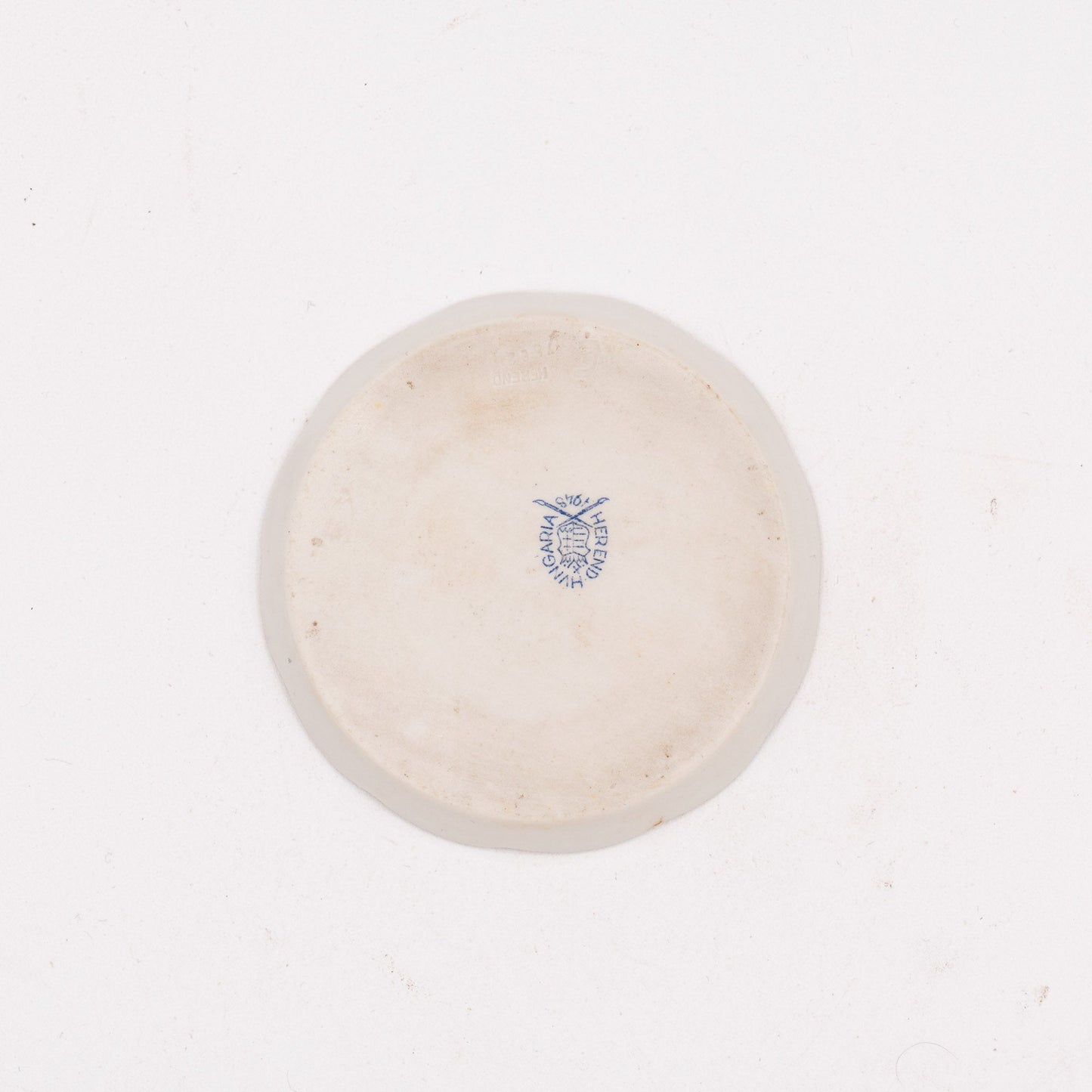Herend
Vintage “Pink Apponyi” Round Pin/Trinket Dish – Herend, Hungary
Vintage “Pink Apponyi” Round Pin/Trinket Dish – Herend, Hungary
Couldn't load pickup availability
Hand-painted in Hungary by Herend, this petite round dish features the refined Apponyi floral - here in the coveted raspberry-pink (also known as Apponyi Purpur).
Framed by Herend’s subtle basketweave moulding and a fine gilt rim, the single peony spray is executed with the lively brushwork that made Herend a favourite of European courts.
Perfect as a butter pat, ring dish, or trinket tray for keys and earrings, it layers beautifully with white porcelain and pink transferware, and adds a graceful accent to dressing tables and coffee trays alike.
- Material: Porcelain, hand-painted with gilt (gold) highlights
- Maker: Herend Porcelain Manufactory
- Motif: Apponyi / Chinese Bouquet in raspberry (often called Pink Apponyi; pattern code AV), stylised peony bouquet with tendrils and gold details
- Style: Classic European luxury porcelain; rococo-inspired scalloped form with basket-weave relief to the rim
- Place of Origin: Herend, Hungary
- Mark: Blue HEREND HUNGARY – HANDPAINTED shield mark (post-1948 export mark). This version is consistent with 1970s–1990s production.
- Date of Manufacture: c. 1970s–1990s
- Condition: Very good vintage condition with light, honest surface wear to the well and minute handling to the gilding commensurate with age; no cracks, chips or repairs noted.
Share
- Worldwide Shipping
- Secure Packaging
- Loving Curation


Origin & Maker
Founded in 1826 in the village of Herend by Vince Stingl and transformed under Mór Fischer from 1839, Herend grew from a small workshop into one of Europe’s most celebrated makers of hand-painted, hard-paste porcelain. International acclaim followed the Great Exhibition in London (1851) and subsequent world fairs, where Herend’s virtuoso painting and rich gilding attracted royal patrons, including Queen Victoria—whose 1851 order gave the famous “Victoria” butterfly-and-peony pattern its name—as well as the Austro-Hungarian court and the Rothschilds (inspiring the charming “Rothschild Bird” design).
Herend’s signature lies in its entirely hand-decorated surfaces: layered enamels, 24-carat gilded details and exquisitely fine outlines. Iconic motifs include Apponyi (a pared-back take on Victoria), the Fishnet/Fish-scale decoration (now synonymous with Herend figurines), and a broad repertoire of Oriental-inspired florals and fauna. Despite nationalisation in the 20th century, the manufactory safeguarded its artisan training and, since privatisation in 1993, continues to produce table services and figurines that marry courtly tradition with meticulous craftsmanship.
Today, collectors prize Herend for its painterly detail, depth of colour, and continuity of hand-work—each piece signed by the artist—making it one of the few European porcelain houses where the 19th-century atelier spirit still defines contemporary production.
Blog posts
View all-

A Serendipitous Morning at the Rue de Bretagne ...
There are few joys in life that match the thrill of stumbling upon a hidden treasure, and for me, flea markets hold that magical allure. One of my favourite flea...
A Serendipitous Morning at the Rue de Bretagne ...
There are few joys in life that match the thrill of stumbling upon a hidden treasure, and for me, flea markets hold that magical allure. One of my favourite flea...
-

Emile Bourgeois and "Le Grand Dépôt" in Paris
Recently, I found this stunning Sarreguemines wash set. It was at the Brocante in Belfort, France. On this day, we had got up at 4 AM to be there in...
Emile Bourgeois and "Le Grand Dépôt" in Paris
Recently, I found this stunning Sarreguemines wash set. It was at the Brocante in Belfort, France. On this day, we had got up at 4 AM to be there in...
-

The Legacy of Robert Haviland: A Journey from N...
The story of Robert Haviland porcelain is one of artistry, transatlantic ambition, and enduring heritage. It begins in the mid-19th century when David Haviland, an enterprising New Yorker, founded Haviland...
The Legacy of Robert Haviland: A Journey from N...
The story of Robert Haviland porcelain is one of artistry, transatlantic ambition, and enduring heritage. It begins in the mid-19th century when David Haviland, an enterprising New Yorker, founded Haviland...





